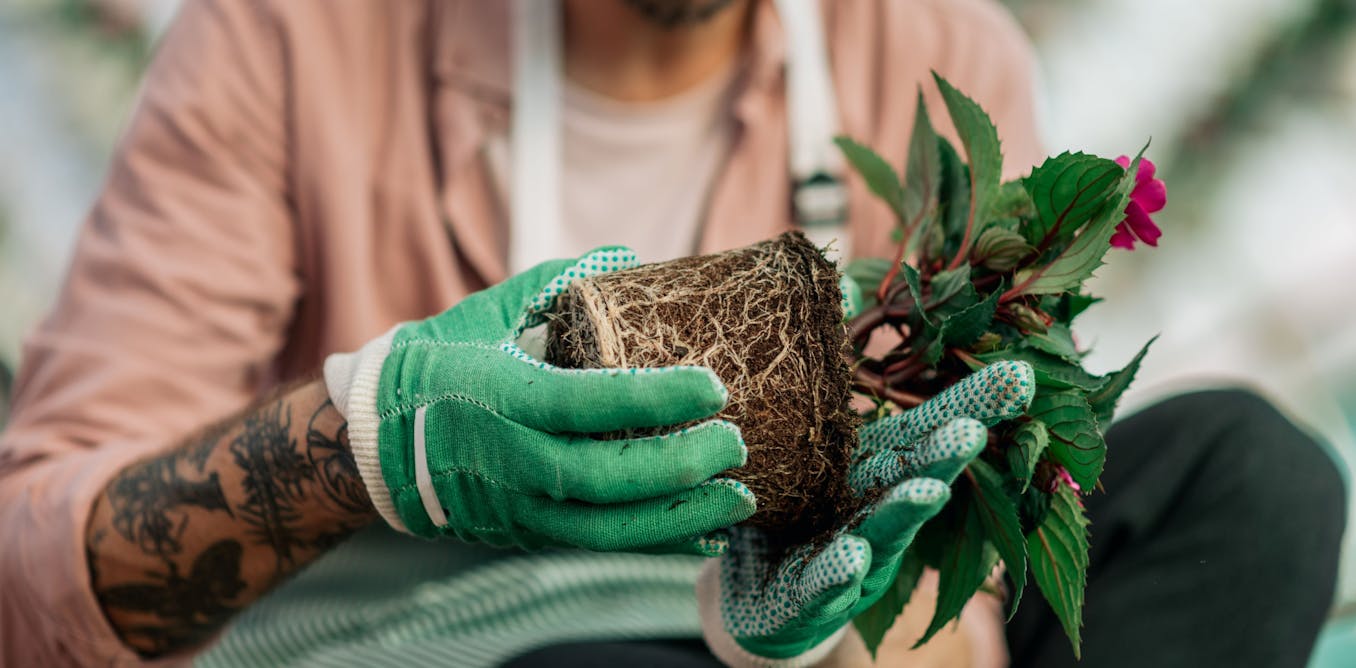
Ever wondered how a delicate plant root can push its way through hard ground? It’s a feat of engineering happening beneath our feet.
Understanding this process is more important than ever as we face escalating droughts and grapple with compacted farmland that threatens our food security. This compaction, often caused by the weight of heavy farm machinery, makes it much harder for roots to access the water and nutrients they need.
Our recent research offers a glimpse into the powerful mechanics roots use to push through tough soils and even fracture solid chalk.
Think of it as X-ray vision, peering into the secret life of roots.
Many people think of plants as nice-looking greens. Essential for clean air, yes, but simple organisms. A step change in research is shaking up the way scientists think about plants: they are far more complex and more like us than you might imagine. This blossoming field of science is too delightful to do it justice in one or two stories.
This story is part of a series, Plant Curious, exploring scientific studies that challenge the way you view plantlife.
Root growth forges channels, known as biopores, which improve water drainage, allowing air and water to permeate deeper into the soil. Biopores also support essential microbial ecosystems, such as bacteria and fungi that interact with plants, many of which require the oxygen these air gaps provide.
To see what’s happening at this minute scale, we couldn’t just dig up a plant. We took our experiment to the Diamond Light Source in the UK.
This science facility is home to a synchrotron, a type of particle accelerator that works like a super-powered microscope. It produces X-rays 10 billion times brighter than the light of the Sun. We focused these X-rays on an artificial root model, which allowed us to make controlled measurements.
First, to see the shape of the soil, we used 3D X-ray imaging, which works like a medical CT scan, to create detailed pictures of the soil structure around the model root. This allowed us to see how the tiny grains and pores in the soil were being squeezed and shifted.
But to measure the invisible forces at play, we needed a different technique called focused X-ray diffraction. Measuring these tiny forces inside a jumble of normal soil grains is impossible.
To solve this, we created a surrogate soil from gypsum, a mineral with a perfectly orderly natural crystal structure. Each crystal in the soil acts as a tiny, measurable spring. When the model root pushes into the soil, these “springs” get compressed or stretched. X-ray diffraction can detect these minute changes.
This approach, observing the soil’s structure change and mapping the forces within it, had never been done before for this kind of problem.
Our experiment worked by holding a model root made of special, sturdy plastic, in a fixed position, while a motor-driven stage pushed the soil sample upwards into it.
As we expected, the 3D images showed a compression zone forming around the tip of our model root. The soil particles were being packed closer together, and the tiny air pockets, or pores, between them were shrinking. This compaction is actually the first step to engineer a lasting pathway through the soil.

maxbelchenko/Shutterstock
The force maps from the X-ray diffraction measurements revealed something surprising. As the model root first pushed in, we saw signs of stress building up in the soil crystals near the tip. But as it penetrated deeper, to about 8 millimetres, the stress in the crystals closest to the tip seemed to ease, even though the overall force required to push the cone increased.
To understand why it was happening, we created a computer simulation of the experiment. The simulation confirmed our theory: the material had begun to yield and deform permanently. Essentially, the soil stopped acting like a compressed spring and started behaving like modelling clay, holding its new shape, and forging the new channel, that will hold even in hard, dry conditions.
For the first time, our method allowed us to map the boundary of this “plastic zone” in the soil. We watched it start as a small region right at the tip and then expand as the model root pushed deeper, showing how far the root’s influence reached into the surrounding soil.
In this zone, the soil particles might be breaking or rearranging themselves into new, smaller configurations. This rearrangement can lead to a relaxation of the elastic stress inside the crystals, even as the overall structure is under great pressure. This doesn’t mean the soil gets easier to push through. Our measurements showed that the overall force required to advance the model root continued to increase, even as this plastic zone grew.
Instead of simply shoving soil aside, a root manages pressure at its tip, causing the soil to yield and flow around it, a far more efficient way to penetrate hard ground.
From lab bench to farmer’s field
This new research method opens the door to studying how plant roots interact with soils in unprecedented detail. We can start to answer questions like “how do different root shapes give some plants an advantage in hard ground?”
Understanding underground engineering has real world implications. Farmers often rely on ploughing to break up the soil surface for planting. But this is energy-intensive, costly for the farmer, and can damage long-term soil health by increasing erosion and releasing stored carbon into the atmosphere.
Identifying root traits that excel in these compacted conditions could help plant breeders develop crop varieties that are more drought-resistant and require less soil preparation.
Appreciating how roots engineer their environment can aid rewilding projects to rejuvenate over-farmed areas. For instance, conservationists could use these insights to select native plants with powerful root traits to act as pioneer crops. Their roots would break up compacted earth, creating new channels for water and paving the way for a richer ecosystem to return.
Peering into the world below us can help us learn how to secure our food supply and regenerate our planet.
![]()
Siul Ruiz receives funding from The Royal Society.
James Le Houx does not work for, consult, own shares in or receive funding from any company or organisation that would benefit from this article, and has disclosed no relevant affiliations beyond their academic appointment.



